Have you ever wondered who has held the prestigious position of Vice President of the Philippines throughout history? With each new vice president comes the potential for great influence and impact. Whether you’re curious about the current Vice President of the Philippines, or you want to explore the rich history of these esteemed individuals, we’ve got you covered. From the early days of the Commonwealth era to the present day, discover the complete list of Philippine Vice Presidents and their contributions to the nation.
Key Takeaways:
- There have been 15 vice presidents in Philippine history.
- Some vice presidents have held the position multiple times, while others have served only one term.
- Several vice presidents have gone on to become presidents of the Philippines.
- The current vice president of the Philippines is Sara Duterte.
- The vice presidency plays a vital role in the government and the presidential line of succession.
History of the Vice Presidency in the Philippines
The office of the vice president in the Philippines has a rich history that dates back to the ratification of the 1935 Constitution. Prior to this, during the Commonwealth of the Philippines under American sovereignty, there was no official position of vice president during the Second Republic.
However, during the martial law era under President Ferdinand Marcos, the office of the vice president was abolished. It was later restored with amendments to the constitution, and the current provisions for the vice president are outlined in the 1987 Constitution of the Philippines.
“The creation and restoration of the office of vice president in the Philippines reflect the evolution of the country’s political landscape. It underscores the importance of having a designated successor and a strong executive team to ensure the efficient functioning of the government.”
List of Philippine Vice Presidents
Here is a comprehensive list of the Vice Presidents of the Philippines, highlighting their respective terms in office:
- Sergio Osmeña
- Elpidio Quirino
- Fernando Lopez
- Carlos P. Garcia
- Diosdado Macapagal
- Emmanuel Pelaez
- Salvador Laurel
- Joseph Estrada
- Gloria Macapagal Arroyo
- Teofisto Guingona Jr.
- Noli de Castro
- Jejomar Binay
- Leni Robredo
- Sara Duterte
Each of these Vice Presidents has made unique contributions during their term in office, further enriching the political landscape of the Philippines.
Quote: “The Vice Presidency is a position of great responsibility, and our Vice Presidents have played crucial roles in shaping the nation’s history and future.” – Philippine Political Historian
The image above showcases the esteemed Vice Presidents who have served the Philippines throughout its rich history.
Notable Vice Presidents in Philippine History
Fernando Lopez, the longest-serving vice president in Philippine history, is widely recognized for his remarkable tenure in office. He served as vice president for a combined total of almost 11 years, making him a prominent figure in Philippine politics. Lopez’s dedication and commitment to public service left a lasting impact on the country, and his remarkable service has earned him a place in the history books.
Another notable vice president is Elpidio Quirino, who holds the record for the shortest time served as vice president in the Philippines. Despite his relatively brief term of approximately 1 year and 11 months, Quirino made significant contributions during his time in office. His leadership skills and unwavering commitment to the nation’s progress are still recognized and appreciated to this day.
Sergio Osmeña is another notable figure in Philippine history, known for succeeding Manuel L. Quezon as vice president. His time in office showcased his resilience and determination in continuing Quezon’s legacy and guiding the nation through challenging times. Osmeña’s contributions reflect his unwavering dedication to his role as vice president and his commitment to serving the Filipino people.
Gloria Macapagal Arroyo is yet another vice president who stands out in Philippine history. Not only did she serve as vice president, but she also went on to become the country’s president. Her leadership during her vice-presidential tenure set the stage for her future accomplishments as the highest-ranking official in the government. Arroyo’s legacy as both vice president and president makes her a truly notable figure in Philippine politics.
Timeline of Vice Presidents in the Philippines
The timeline of Philippine vice presidents provides a historical perspective on the individuals who have served in this important role throughout the country’s history. From the early years of the Commonwealth era to the present day, each vice president has left their mark on Philippine politics and governance.
| Vice President | Years of Service |
|---|---|
| Sergio Osmeña | 1935-1944 |
| Elpidio Quirino | 1946-1953 |
| Fernando Lopez | 1949-1953, 1965-1973 |
| Carlos P. Garcia | 1953-1957 |
| Diosdado Macapagal | 1957-1961 |
| Emmanuel Pelaez | 1961-1965 |
| Salvador Laurel | 1986-1992 |
| Joseph Estrada | 1992-1998 |
| Gloria Macapagal Arroyo | 1998-2001 |
| Teofisto Guingona Jr. | 2001-2004 |
| Noli de Castro | 2004-2010 |
| Jejomar Binay | 2010-2016 |
| Leni Robredo | 2016-2022 |
| Sara Duterte | 2022-present |
Each vice president’s term reflects a specific period in the country’s history, characterized by political, social, and economic developments. Understanding the timeline of Philippine vice presidents provides valuable insights into the progression of leadership in the Philippines and how it has shaped the nation’s path.
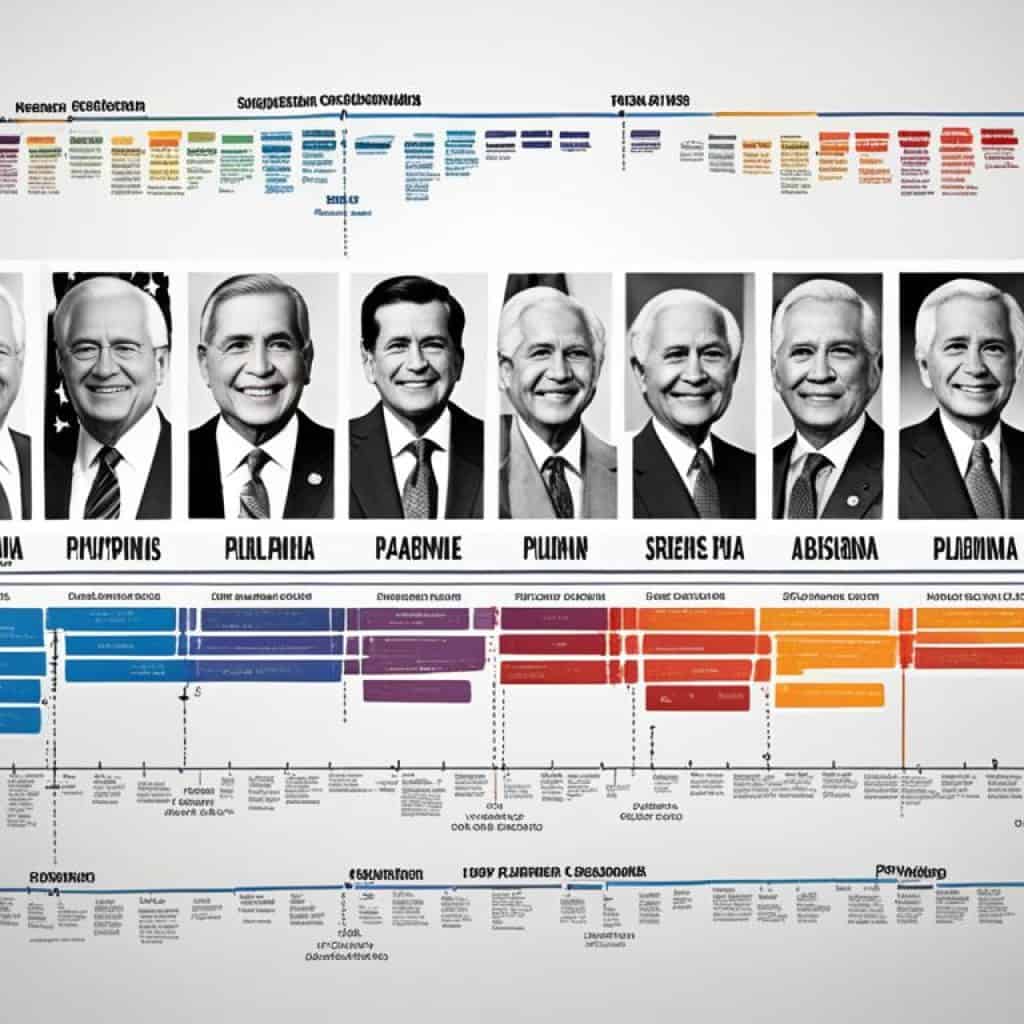
Unofficial Vice Presidents of the Philippines
In Philippine history, there have been individuals who held the vice presidency of a government intended to represent the Philippines but are not officially recognized by the Philippine government as part of the presidential succession. These unofficial vice presidents played significant roles in their respective governments, but their terms of office are not counted in the official list of vice presidents.
Among these unofficial vice presidents are:
- Mariano Trías
- Francisco Carreón
- Ramón Avanceña
- Benigno Aquino Sr.
- Arturo Tolentino
While these individuals held the vice presidency, their exclusion from the official presidential succession reflects the complex nature of political transitions and the specific circumstances surrounding their governments.
A Historical Perspective
“The inclusion or exclusion of these individuals as official vice presidents of the Philippines offers a fascinating glimpse into the nuanced history of Philippine politics.”
Although not formally recognized, their contributions to Philippine governance and their roles within their respective governments cannot be overlooked. Their presence and influence shaped important policies and decisions, leaving a lasting impact on the political landscape of the Philippines.
Notable Achievements
Each of these individuals had unique achievements during their time as unofficial vice presidents. Mariano Trías, for instance, played a crucial role in the Philippine Revolution against Spanish colonial rule. Benigno Aquino Sr., known for his outspoken advocacy for Philippine independence, left a significant legacy in the fight for self-governance.
While they may not be officially recognized in the presidential succession, their achievements and contributions should be acknowledged and celebrated as valuable contributions to Philippine history.
Vice Presidents Who Became Presidents
Throughout Philippine history, there have been instances where vice presidents successfully ascended to the presidency, either due to the death or resignation of the incumbent president. These remarkable individuals stepped into the highest office of the land, assuming the responsibilities and challenges that come with leading the nation.
One such vice president who became president was Sergio Osmeña. Following the death of President Manuel L. Quezon in 1944, Osmeña assumed the presidency and served until 1946. His leadership during the tumultuous period of World War II and the country’s recovery was crucial in shaping the nation’s future.
Elpidio Quirino is another vice president who succeeded to the presidency. After the assassination of President Manuel Roxas in 1948, Quirino took office and served as the president until 1953. He played a vital role in stabilizing the country and initiating economic reforms.
Carlos P. Garcia, who served as vice president from 1957 to 1961, also became the president when President Ramon Magsaysay tragically died in a plane crash. Garcia’s presidency was marked by his advocacy for Filipino nationalism and economic self-sufficiency.
Diosdado Macapagal, vice president from 1957 to 1961, succeeded President Garcia in 1961 and served until 1965. As president, Macapagal implemented significant reforms, including land redistribution and economic policies aimed at reducing poverty.
Another notable vice president who became president is Gloria Macapagal Arroyo. She took office in 2001 after President Joseph Estrada’s resignation. Arroyo’s presidency was marked by her focus on economic development and social welfare initiatives.
The journey from vice president to president is one that requires adaptability, leadership, and a deep sense of responsibility. These vice presidents turned presidents have left their indelible mark on the Philippines, shaping its history and guiding the nation through critical moments of change and transformation.
Ranking of Vice Presidents by Length of Term
When it comes to the longest-serving Philippine Vice Presidents, two names stand out: Fernando Lopez and Sergio Osmeña. Fernando Lopez holds the record for the longest time served, totaling an impressive 10 years and 274 days in office. Sergio Osmeña, on the other hand, ranks second with a single tenure of 8 years and 260 days.
Let’s take a closer look at the vice presidents who have spent the most time in office:
| Vice President | Length of Term |
|---|---|
| Fernando Lopez | 10 years, 274 days |
| Sergio Osmeña | 8 years, 260 days |
| Carlos P. Garcia | 6 years, 5 days |
| Gloria Macapagal Arroyo | 6 years |
| Joseph Estrada | 3 years, 7 months, 16 days |
These vice presidents have served the nation with dedication and have shown remarkable commitment to their roles. Their lengthy terms in office allowed them to make significant contributions to the country and its people.

Vice Presidents with Previous Executive Experience
Some vice presidents in the Philippines have had previous executive experience, which has greatly influenced their roles and contributions during their tenure. Two notable examples are Elpidio Quirino and Diosdado Macapagal, both of whom served as cabinet secretaries before ascending to the position of vice president.
Elpidio Quirino served as Secretary of Finance under President Manuel Roxas from 1946 to 1950. During his time in this executive position, Quirino implemented significant economic policies aimed at stabilizing the Philippine economy and promoting sustainable growth.
Diosdado Macapagal, on the other hand, served as Secretary of Foreign Affairs under President Carlos P. Garcia from 1957 to 1961. As a former cabinet secretary, Macapagal played a crucial role in shaping the country’s foreign relations and diplomatic efforts.
Both Quirino and Macapagal brought with them a wealth of knowledge, expertise, and leadership skills from their previous executive roles. This background enabled them to contribute effectively to the development and governance of the Philippines as vice presidents.
“Having previous executive experience as cabinet secretaries provided Quirino and Macapagal with a deep understanding of governance and policy-making. This experience undoubtedly influenced their approach and decision-making as vice presidents, further contributing to their overall effectiveness in the role.”
Comparative Table: Executive Experience of Vice Presidents
| Vice President | Previous Executive Experience |
|---|---|
| Elpidio Quirino | Secretary of Finance |
| Diosdado Macapagal | Secretary of Foreign Affairs |
By leveraging their previous executive experience, vice presidents like Quirino and Macapagal were able to provide valuable insights and perspectives in addressing the diverse challenges and responsibilities that come with the role. Their contributions underscore the importance of combining executive expertise with the vice presidency’s unique position in Philippine politics.
Vice Presidents with Legislative Backgrounds
Several Philippine vice presidents have had legislative backgrounds, including Sergio Osmeña, Elpidio Quirino, and Fernando Lopez, who all served as senators before being elected vice president. Their experience in the legislative branch provided them with a strong foundation for their role as vice president.
| Vice President | Legislative Experience |
|---|---|
| Sergio Osmeña | Served as a senator before becoming vice president |
| Elpidio Quirino | Previously served as a senator |
| Fernando Lopez | Held a seat in the Senate before becoming vice president |
These vice presidents brought their knowledge of the legislative process, lawmaking, and public service to their roles. Their experience as senators allowed them to navigate the complexities of government and contribute effectively to the executive branch.
By leveraging their understanding of legislative procedures, these vice presidents were equipped to collaborate with lawmakers, enact laws, and represent the interests of the people they served. Their legislative backgrounds enriched their decision-making abilities, enabling them to make informed policy decisions and advocate for meaningful reforms.
Having a legislative background provides valuable insights and skills that can greatly benefit vice presidents in effectively fulfilling their duties and responsibilities. The experiences gained in the legislative branch help shape their governance approach and their ability to bridge the gap between the executive and legislative branches of the government.
Other Positions Held by Vice Presidents
In addition to serving as vice president, several individuals have held other significant positions in the Philippine government. These roles allowed them to contribute their expertise and knowledge to the development and governance of the country.
One notable example is Teofisto Guingona Jr., who served as the Chairman of the Metropolitan Manila Development Authority. In this capacity, Guingona played a crucial role in managing and transforming the metropolitan area, enhancing its infrastructure and services for the benefit of its residents. His leadership and strategic vision contributed to the overall development and progress of Manila.
Gloria Macapagal Arroyo also held a noteworthy position in the Philippine government. Prior to becoming vice president, she served as the Undersecretary of the Department of Trade and Industry. In this role, Arroyo played a key role in promoting trade and industry, fostering economic growth, and creating opportunities for both local and international businesses. Her efforts greatly contributed to the expansion of trade and investment in the Philippines.
Quote:
“By taking on these additional roles, these vice presidents demonstrated their commitment to serving the Filipino people in various capacities. Their expertise and dedication in their respective positions have undeniably shaped the course of Philippine governance and development.”
These are just some examples of vice presidents who have held other positions in the Philippine government. The diverse backgrounds and experiences of these individuals have enriched their leadership and allowed them to make significant contributions to the overall progress and prosperity of the country.
This image illustrates the dynamic nature of the vice presidency and the various roles played by vice presidents in the Philippine government. It serves as a reminder of the valuable expertise and contributions these individuals bring to the table in serving the Filipino people and driving positive change in the nation.
Notable Achievements of Philippine Vice Presidents
During their terms in office, Philippine vice presidents have made significant contributions to the country, leaving a mark on Philippine history through their achievements. Their dedication and efforts have helped shape the development and progress of the nation.
One notable vice president, Salvador Laurel, played a key role in the EDSA People Power Revolution, a significant event that led to the restoration of democracy in the Philippines. His unwavering commitment to the cause and his efforts in mobilizing the Filipino people were instrumental in bringing about positive change.
“The EDSA People Power Revolution was a defining moment in Philippine history. It was a testament to the power of the Filipino people and their desire for a better future. I am honored to have played a part in this historic event.” – Salvador Laurel
Another vice president, Jejomar Binay, implemented various programs and initiatives aimed at improving housing and infrastructure in the Philippines. Through his leadership, affordable housing projects were established, providing shelter for many Filipino families in need. Additionally, he spearheaded infrastructure development projects, enhancing connectivity and contributing to the country’s economic growth.
These are just a few examples of the remarkable achievements of Philippine vice presidents throughout history. Each vice president has made unique contributions to the betterment of the Philippines, leaving a lasting impact on the nation and its people.
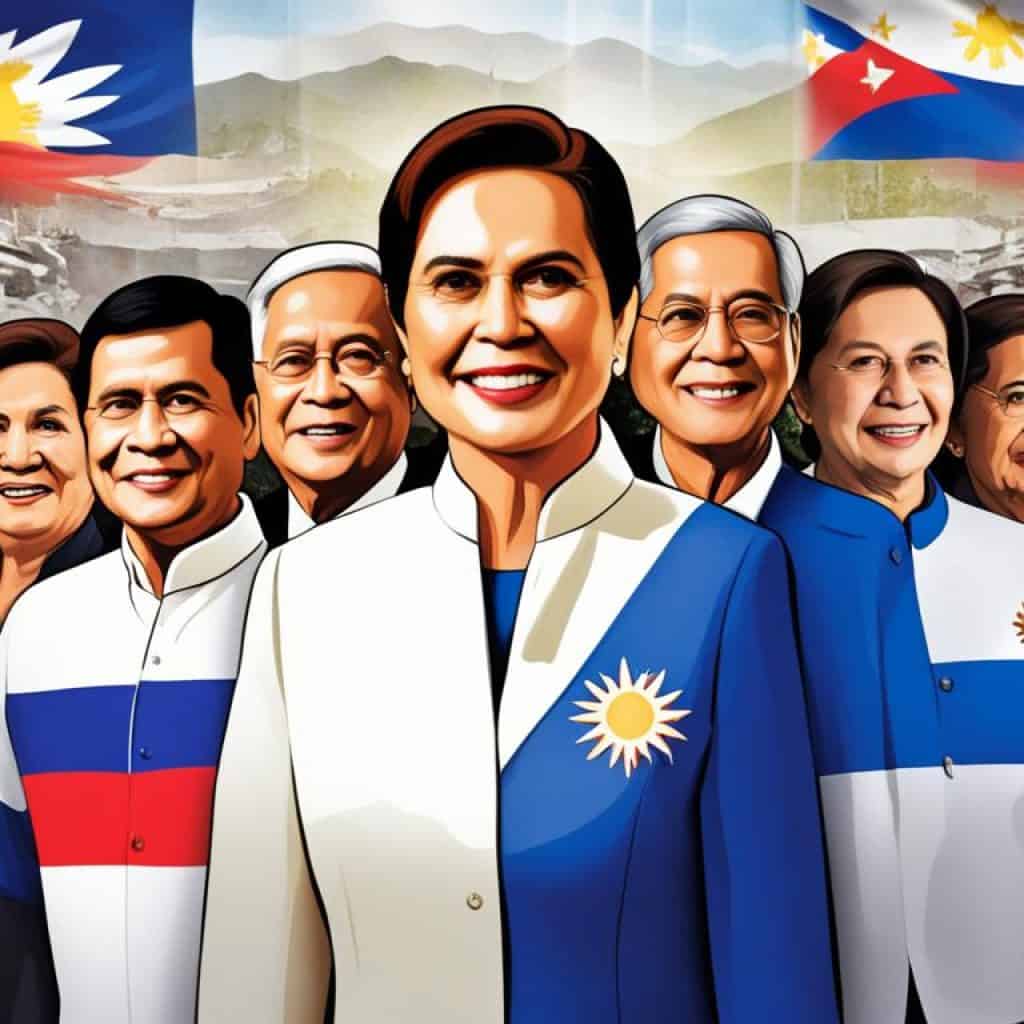
Current Vice President of the Philippines
As of now, Sara Duterte serves as the current Vice President of the Philippines. She assumed office on June 30, 2022.
The Vice President of the Philippines holds significant duties and powers within the government. As the second-highest executive official in the country, the Vice President plays a crucial role in the political landscape. They are the first in the presidential line of succession, ready to assume the duties of the presidency if the need arises.
| Duties and Powers |
|---|
| Serves as the second-highest executive official in the government |
| First in the presidential line of succession |
| May also serve as a cabinet member without confirmation from the Commission on Appointments |
The Vice President of the Philippines plays a crucial role in shaping and influencing the policies and governance of the nation. With their extensive responsibilities and powers, Vice Presidents contribute to the overall development and progress of the Philippines.
The image below showcases the current Vice President of the Philippines, Sara Duterte.
Continue reading to explore more about the history, notable achievements, and future prospects of the Philippine Vice Presidency.
Future of the Vice Presidency in the Philippines
The future of the vice presidency in the Philippines holds great potential for change and development. As the political landscape evolves and constitutional amendments are considered, the role and responsibilities of the vice president may undergo significant transformations. It is an exciting time that offers new opportunities for the vice presidency to address the changing needs and priorities of the country.
One possible area of change in the future is the expansion of the vice president’s role in policy-making and governance. With a deeper focus on collaborative decision-making, the vice president could have a more active involvement in shaping policies and implementing programs that directly benefit the Filipino people. This shift would enable the vice president to become an influential voice in the development and implementation of key initiatives.
Furthermore, the future may bring about a more prominent Vice Presidency that serves as a bridge between different branches of government. By fostering stronger relationships and collaboration with the executive, legislative, and judicial branches, the vice president can play a pivotal role in promoting unity, consensus-building, and democratic governance.
“The future of the vice presidency lies in its ability to adapt, innovate, and contribute to the overall progress and prosperity of the Philippines.”
Additionally, there is potential for the vice president to take on a more active role in representing the country on the international stage. By leveraging their position and influence, the vice president can engage in diplomatic efforts, promote foreign relations, and advocate for the interests of the Philippines in the global arena.
The future also holds the possibility of empowering the vice presidency to become a vehicle for inclusivity and amplifying underrepresented voices. By championing diversity, equity, and inclusion, the vice president can advocate for marginalized communities, highlight social issues, and drive positive change towards a more inclusive society.
In summary, the future of the vice presidency in the Philippines is full of promise and potential. Through political developments and constitutional amendments, the role of the vice president may evolve to meet the changing needs and priorities of the country. By embracing this evolution, the vice president can serve as a catalyst for positive change, contributing to the overall progress and prosperity of the Philippines.
Conclusion
The vice presidency in the Philippines has played a pivotal role in the country’s history and governance, with vice presidents making significant contributions to the nation’s development and progress. From the early years with Sergio Osmeña to the present day with Sara Duterte, each vice president has left a lasting impact on the political landscape of the Philippines.
Throughout their terms in office, vice presidents have provided leadership, support, and representation to the Filipino people. They have been instrumental in shaping policies, advocating for the interests of the nation, and assisting the president in governing the country. Their dedication and service have been vital in advancing the welfare and prosperity of the Philippines.
As the country moves forward, the vice presidency will continue to hold a vital position in the government. It will serve as a pillar of strength, ensuring the continuity of effective leadership and governance. The vice president will remain a trusted advisor to the president, a champion for the people, and a catalyst for positive change in the Philippines.
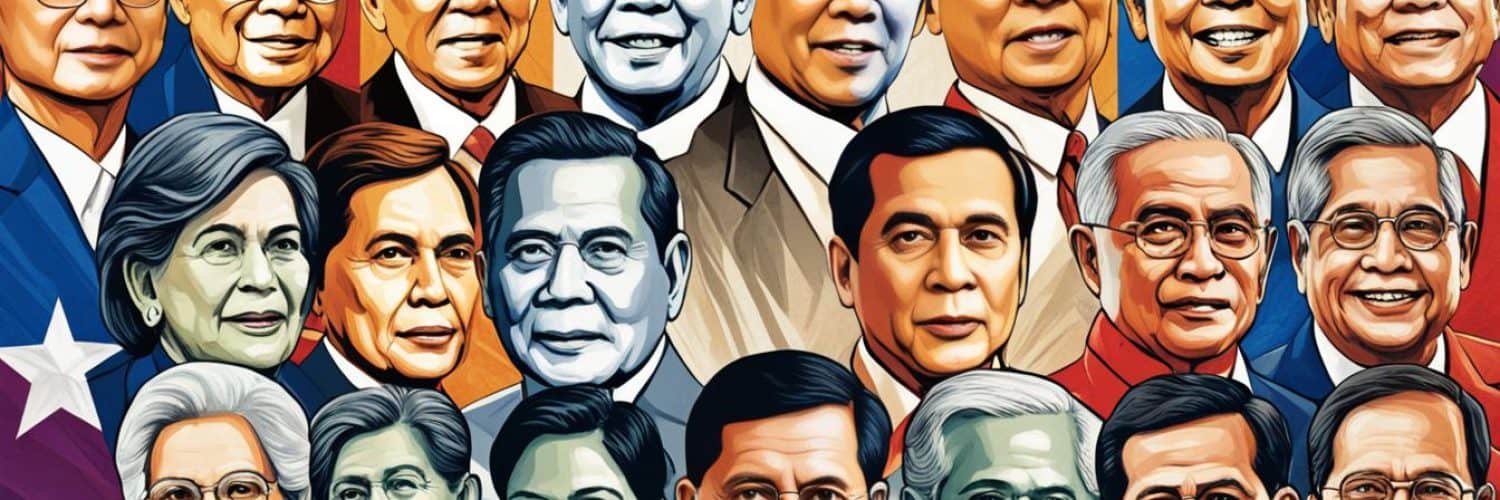
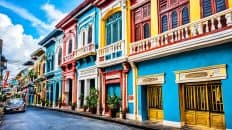
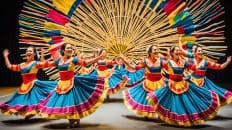
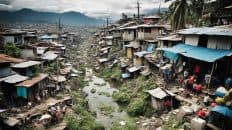










Add comment